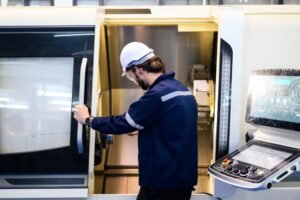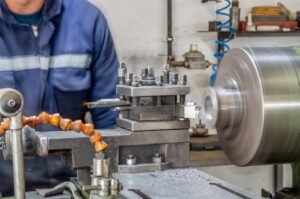Its Advantages, Characteristics, and Application Specificity
Advantages of Swiss-Style Turning
- Exceptional Precision and Accuracy
The standout feature of Swiss-style turning is its ability to achieve micron-level tolerances. For instance, orthopedic screws often require tolerances of ±0.0002 inches. Achieving this consistently on a traditional lathe is difficult. On a Swiss lathe, however, this level of precision is routine.
- Part Stability from Guide Bushing and Sliding Headstock
The sliding headstock pushes material through the guide bushing so only a short section is exposed at a time. This design makes it possible to machine long, thin, or flexible parts—such as catheter guidewires or aerospace pins—that would chatter or bend on a conventional lathe.
In practice, Swiss turning holds the part as if a craftsman grips a violin bow: firmly supported, yet agile enough for delicate performance.
- Multi-Axis Machining and Complex Features in One Setup
Multi-spindle Swiss lathes today commonly boast up to a dozen axes of coordinated motion. That means turning, milling, drilling, and tapping can be done in a single cycle.
Case in point: A dental implant manufacturer reduced cycle time by 40% by moving from a lathe-plus-milling process to one Swiss machine that handled everything. Fewer setups also mean fewer handling errors—a major win for quality assurance.
- Speed, Productivity, and Lights-Out Manufacturing
Swiss machines are designed for continuous, unattended production. With bar feeders and chip conveyors, many facilities run Swiss lathes overnight or through weekends with minimal supervision.
For industries like consumer electronics, where millions of micro parts are needed, this automation is the difference between meeting demand and falling behind.
- Superior Surface Finish and Reduced Post-Processing
Because of the rigid support, Swiss-turned parts often come off the machine with a finish so smooth that secondary polishing or grinding isn’t needed. That not only saves money but also shortens delivery times.
- Material Efficiency and Waste Reduction
Material costs add up quickly—especially with titanium or cobalt-chrome. Swiss machines minimize waste thanks to bar-feeding systems and precise control. Lower scrap rates directly improve profit margins.
- Broad Material and Industry Compatibility
Swiss lathes can machine stainless steel, titanium, plastics, and exotic alloys. This versatility explains their role across industries: medical (implants), aerospace (fasteners), defense (guidance components), and consumer electronics (micro pins).
Technical Characteristics
- Guide Bushing: Purpose and Mechanism
Guide bushings are indispensable for the unique operation of Swiss lathes. It holds the bar stock firmly at the point of cutting, which is why these machines can maintain tight tolerances on long, slender parts.
- Sliding Headstock vs Fixed Headstock
The key feature of a Swiss lathe is its sliding headstock, which pushes the workpiece forward via the guide bushing. Contrast this with a conventional lathe, where the stock is clamped at one end and hangs unsupported. The Swiss design dramatically reduces vibration and enables parts with length-to-diameter ratios of 20:1 or more.
- Coolant Choices: Oil vs Water
Swiss machines typically rely on oil-based coolant, which offers better lubrication and tool life compared to water-based systems. The trade-off is higher operating costs and more maintenance to control oil temperature. For high-value parts like aerospace bushings, the cost is justified.
- Automation and Live Tooling Capabilities
Live tooling allows cross-drilling, milling, engraving, and slotting in one pass. Combined with automation such as bar feeders, Swiss lathes support lights-out production, maximizing uptime while reducing labor costs.
- Repeatability in Long Runs
Swiss lathes shine in repeatability. Once programmed and dialed in, they can run for months producing identical parts with virtually zero deviation. That reliability is why they dominate in high-volume sectors like electronics.
Application Specificity
- Long, Thin, or Micro Parts (Shafts, Screws, Pins)
If a part is slender, delicate, or measured in millimeters, Swiss turning is usually the answer. Examples include surgical screws, catheter components, and watch stems.
- Complex Multi-Feature Components
Parts requiring threads, cross-holes, or slots benefit from Swiss lathes’ multi-axis capabilities. For example, an electronics connector with multiple ports can be machined in a single cycle, eliminating costly secondary setups.
- High-Volume, Precision-Critical Production
When parts are produced in the millions, small savings compound. Swiss turning reduces scrap, ensures repeatability, and cuts cycle times—delivering the lowest cost per part in precision-critical industries.
- Comparison with Traditional Lathes
For shorter production runs and the machining of larger, simpler workpieces, conventional lathes highly effective. In contrast, Swiss lathes lead in applications demanding tight tolerances, complex geometries, and higher output volumes.
Think of it this way: if traditional lathes are the workhorses of machining, Swiss lathes are the racehorses—designed for speed, agility, and precision.
Cost and Operational Considerations
- Investment vs Long-Term Efficiency
Swiss lathes carry a higher upfront price, but they often pay for themselves quickly through shorter cycle times, reduced waste, and fewer secondary operations. For companies producing precision parts daily, the long-term economics favor Swiss turning.
- Setup Complexity and Operator Skill
Programming a Swiss machine is more complex due to its multiple axes and offsets. Skilled operators are essential. However, training investments are rewarded with consistently higher-quality output.
- Return on Investment and Production Scale
In high-volume industries, ROI can be achieved in under two years. For job shops dealing primarily with prototypes or limited production quantities, standard lathes often present a more practical investment.
Decision Guide: When to Choose Swiss vs Traditional
- Choose Swiss: high-volume medical screws, aerospace pins, precision electronics, micro parts.
- Choose Traditional: large automotive shafts, custom prototypes, small-batch runs.
Case Studies and Industry Examples
Medical Applications (Implants, Bone Screws)
A U.S. medical device company cut rejection rates by 60% after moving bone screw production to Swiss lathes. This change minimized the requirement for polishing, resulting in lower costs and faster delivery times.
Electronics and Connectors
Swiss turning is critical for producing connectors with tight tolerances and cross-holes. In smartphone production, millions of micro pins must be identical. Swiss machines make that possible without compromising throughput.
Aerospace and Watch Components
- Aerospace: Swiss lathes ensure precision for flight-critical fasteners and bushings.
- Watchmaking: The birthplace of Swiss turning, where even microscopic imperfections are unacceptable.
Conclusion
Swiss-style turning offers a combination of precision, productivity, and versatility unmatched by traditional methods. The higher upfront investment is balanced by lower scrap, reduced cycle times, and the ability to scale production with confidence.
The real takeaway is this: it’s not about Swiss vs traditional—it’s about using the right tool for the right part. For industries where scale meets precision, Swiss turning is the smarter bet.




